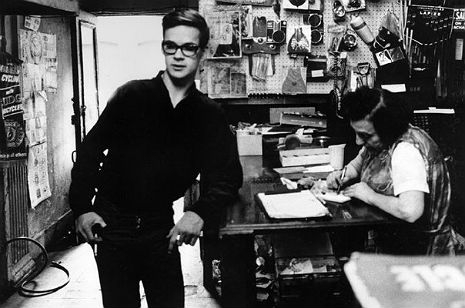Since he was both a Harvard math major and a member (along with John Cale and Angus Maclise from the Velvet Underground) of La Monte Young’s drone ensemble the Theatre of Eternal Music (aka “The Dream Syndicate”) it makes sense that artist/musician Tony Conrad would produce a hypnotic film that combined his studies in mathematics and structure with his interest in the psychoactive effects of repetitive or prolonged intervals of pure sound.
The result is “The Flicker,” a film legendary from being mentioned in dozens upon dozens of books on underground film, “expanded cinema” and the Velvet Underground. Few have seen it since the 1960s.
It begins with a message:
WARNING. The producer, distributor, and exhibitors waive all liability for physical or mental injury possibly caused by the motion picture “The Flicker.” Since this film may induce epileptic seizures or produce mild symptoms of shock treatment in certain persons, you are cautioned to remain in the theatre only at your own risk. A physician should be in attendance.
A frame then reads “Tony Conrad Presents” followed by a stylized quasi-Fluxus looking title card. The screen goes white. The screen goes black. When it starts to speed up, the stroboscopic effects are not just similar to—but in my opinion far superior to—the internal visions created by Brion Gysin’s psychoactive kinetic sculpture, Dreamachine.

Conrad told Hyperreal:
When I made the film “The Flicker” in 1965-66 my principal motivation was to explore the possibilities for harmonic expression using a sensory mode other than sound. The experience of “flicker” - its peculiar entrapment of the central nervous system, by ocular driving - occurs over a frequency range of about 4 to 40 flashes per second (fps). I used film (at 24 fps) as a sort of “tonic,” and devised patterns of frames which would represent combinations of frequencies - heterodyned, or rather multiplexed together. I was interested to see whether there might be combination-frequency effects that would occur with flicker, analogous to the combination-tone effects that are responsible for consonance in musical sound.
I don’t think he was whistling “Dixie” when it came to that warning, btw. If a strobe light can set off an epileptic seizure, surely “The Flicker” could. If I haven’t already scared you off, sit with it long enough and you can get a high that’s similar to bed spins without the nausea (I mean that in a good way!)
Here’s an excerpt from “The Flicker” on YouTube. Although it’s a little ratty-looking, you can still more or less “get” the effect. There is a clean version (that compensates for film to video conversion) that you can find floating around on torrent trackers and various “artsy” film blogs. I highly recommend looking for it, it’s really neat.






